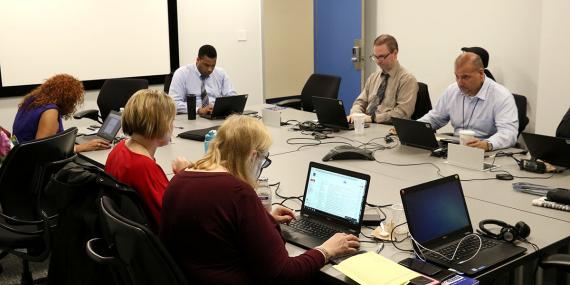Region 2 response and recovery teams participate in annual COOP exercise
By Amanda Smith
NEW YORK — To test GSA’s readiness capabilities and operating procedures in the event of a emergency or natural disaster, Region 2’s Office of Mission Assurance conducted its annual continuity of operations (COOP) exercise May 16.

Teams from Region 2’s workforce responsible for response and recovery missions gathered at 201 Varick St. to practice implementing exercise actions during an emergency situation. This year’s exercise centered around the fictitious Hurricane Frank, specifically five days after it made landfall in the New York City area. The simulated scenario included complete power outages in Brooklyn, Queens and Long Island and partial outages in Manhattan and Northern New Jersey.
“Each year, we test our operating procedures to ensure that our response and recovery teams are fully prepared to execute the region’s COOP plan in the event of an emergency or natural disaster,” said Courtney Dietzler, deputy regional emergency coordinator and exercise director.
On hand to assist OMA and evaluate GSA’s performance in the exercise was FEMA Region 2 Branch Chief for Analysis and Integration and National Preparedness Russell Fox.
“COOP exercises are required by the federal government, but it’s even more important that employees are prepared for emergencies and natural disasters. Other federal agencies rely on GSA for supplies, vehicles, buildings and more. If GSA is unable to function in a crisis, it would directly impact the federal response system,” Fox said.
During these exercises, OMA uses four performance measurements to determine GSA’s readiness capabilities:
- COOP plans, policies, and procedures.
- The interoperability at the regional special security office alternate site, including internal and external communications.
- The performance of essential functions, processes, and procedures.
- The ability to develop policy options in coordination with other efforts to reconstitute regional SSO offices.
“If you exercise, you are more likely to be ready for a real-world situation and can adjust accordingly. You have the opportunity to evaluate what works and what doesn’t in a low-risk environment. It’s OK to find new processes as you want to learn during an exercise,” Fox said.
While COOP exercises are routine for many, others were introduced to the procedures for the first time. For GSA Northeast and Caribbean Regional Administrator John A. Sarcone III, the exercise was a new experience in planning for various sub-scenarios during an emergency or natural disaster.
“We have a great recovery and response system in place throughout our region. Our employees have completed these exercises before and everyone has been at it a long time. The hope is these emergency operating procedures are rarely executed, but our workforce remains extremely prepared and ready in the event of a crisis. I learned a lot,” Sarcone said.
Once the exercise concluded, Faye Wilkes, a supervisory emergency management specialist from OMA Headquarters’ talked with teams to evaluate the performance, discuss initial observations and offer feedback.
“This is how an exercise is supposed to flow. From the top down, this is exactly how it’s supposed to be. Command and control and everybody split off like they should. You met every goal and objective that we had listed internally and externally,” Wilkes said.
After catastrophic hurricane seasons in previous years, Fox said it’s important to look to the past to better prepare for the future. The aftermath of Hurricanes Maria, Sandy and Irene were devastating to areas within Region 2 and brought extensive amounts of unexpected flooding and damage that crippled day-to-day operations for millions of people.
“Scenarios that seem unlikely can become likely and that’s what COOP exercises are for. We have to plan accordingly for all scenarios,” Fox said. “You hope you never have to execute these procedures, but it’s always best to be prepared for anything.”

 U.S. General Services Administration
U.S. General Services Administration